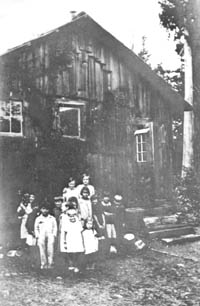The Sunshine Coast
Egmont
 Egmont School
Egmont School
shishalh Nation
The shishalh Nation has lived in the Egmont area since time immemorial, creating a rich culture celebrated for a deep connection to place and understanding of the coastal landscape. shishalh stone tool artifacts found on the present-day Sunshine Coast date upwards of 10,000 years before present and represent a continuous occupation of this area. Their territory is considered unceded, meaning that no official treaty was ever signed allowing for the transfer of their lands to the federal or provincial governments.
Settlement and Pre-Emption
The settlement of portions of British Columbia was encouraged through pre-emption, a process which was formalized through the 1870 Land Ordinance. This allowed settlers to pre-empt (claim) large tracks of land for a nominal fee. While pre-emption benefitted the fledgling country and settlers, it was a tool used to disenfranchise First Nations from their traditional territory and occupy their land. Both First Nations and Chinese settlers were not able to pre-empt land under the Lands Act.
Egmont, the northernmost settlement on the Sechelt Peninsula, was founded in 1880 by a legendary half-Scottish, half-Portuguese seaman and trader named Joseph Silvia Simmonds. He had worked for the Hudson's Bay Company, prospected in the Caribou and built a saloon in Vancouver before arriving in Egmont where he married a Native woman, Lucy Kwatleematt. Simmonds later dropped his surname and used the name Silvey. His descendants still live in the Egmont area. More information on Portuguese Joe Silvey can be found through Harbour Publishing's book "The Remarkable Adventures of Portuguese Joe Silvey."
Egmont is also home of the Egmont Heritage Centre, which can be contacted at 604-883-9994 or [email protected]
The shishalh Nation has lived in the Egmont area since time immemorial, creating a rich culture celebrated for a deep connection to place and understanding of the coastal landscape. shishalh stone tool artifacts found on the present-day Sunshine Coast date upwards of 10,000 years before present and represent a continuous occupation of this area. Their territory is considered unceded, meaning that no official treaty was ever signed allowing for the transfer of their lands to the federal or provincial governments.
Settlement and Pre-Emption
The settlement of portions of British Columbia was encouraged through pre-emption, a process which was formalized through the 1870 Land Ordinance. This allowed settlers to pre-empt (claim) large tracks of land for a nominal fee. While pre-emption benefitted the fledgling country and settlers, it was a tool used to disenfranchise First Nations from their traditional territory and occupy their land. Both First Nations and Chinese settlers were not able to pre-empt land under the Lands Act.
Egmont, the northernmost settlement on the Sechelt Peninsula, was founded in 1880 by a legendary half-Scottish, half-Portuguese seaman and trader named Joseph Silvia Simmonds. He had worked for the Hudson's Bay Company, prospected in the Caribou and built a saloon in Vancouver before arriving in Egmont where he married a Native woman, Lucy Kwatleematt. Simmonds later dropped his surname and used the name Silvey. His descendants still live in the Egmont area. More information on Portuguese Joe Silvey can be found through Harbour Publishing's book "The Remarkable Adventures of Portuguese Joe Silvey."
Egmont is also home of the Egmont Heritage Centre, which can be contacted at 604-883-9994 or [email protected]

